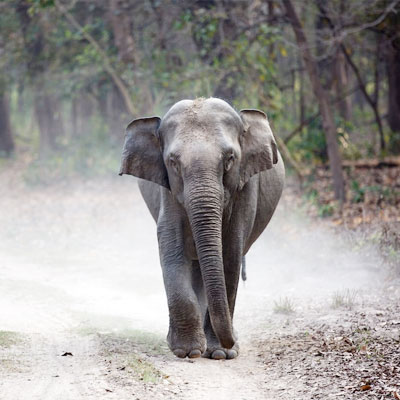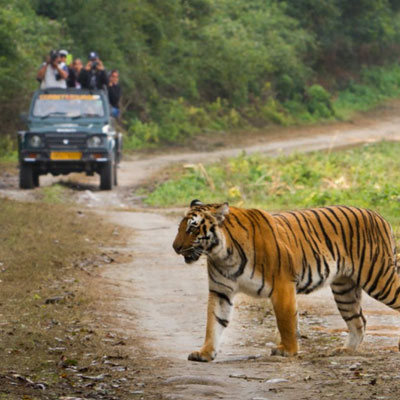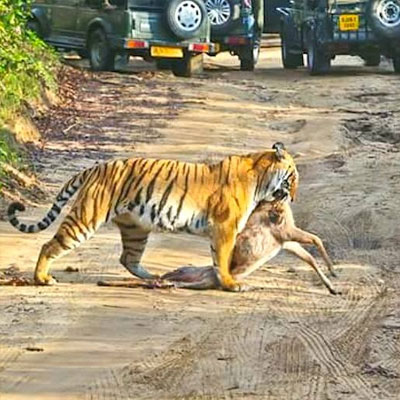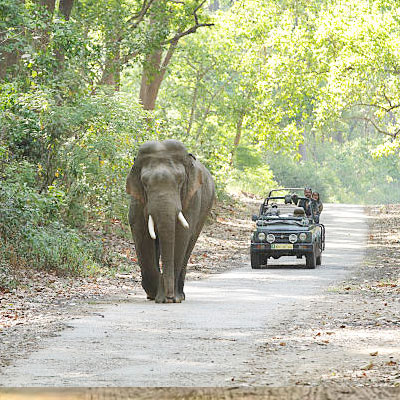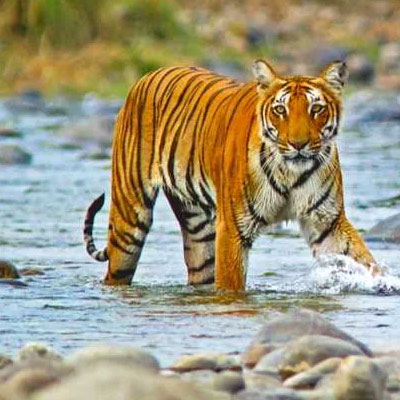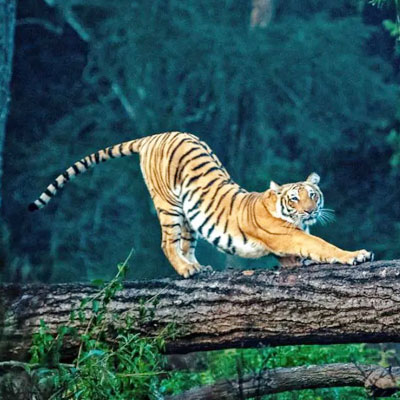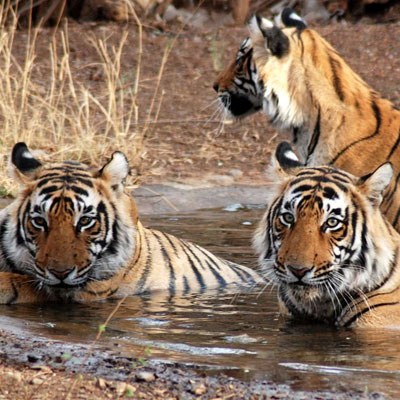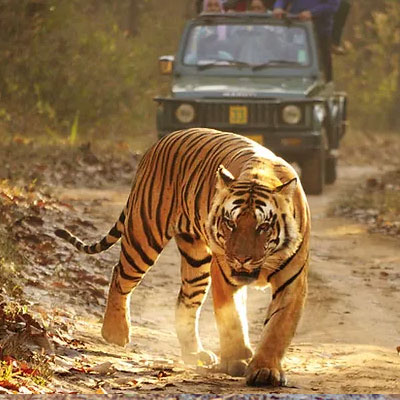
Best Time To Visit Jim Corbett
Jim Corbett National Park is blessed with abundant natural beauty, and its landscape is characterized by the presence of several rivers, lush forests, and diverse flora and fauna. Here’s a look at the prominent rivers in the Corbett region and the park’s rich natural attributes:
Rivers in Jim Corbett National Park:
Ramganga River: The Ramganga River is the primary river that flows through Jim Corbett National Park. It is a perennial river and forms the lifeline of the park. The river is known for its crystal-clear waters and is home to a variety of aquatic species, including the Gharial and Mugger Crocodile. The Ramganga River provides a source of water for the park’s wildlife and supports a thriving ecosystem.
Kosi River: The Kosi River flows through the eastern part of the park and is another important river in the region. It adds to the diversity of the park’s landscape and provides water and habitat for various wildlife species. Kosi River is also known for its scenic beauty and is a popular spot for birdwatching and picnics.
Sonanadi River: The Sonanadi River is a tributary of the Ramganga River and flows through the Sonanadi Wildlife Sanctuary, which is a part of the Corbett Tiger Reserve. This river adds to the overall biodiversity of the region and is a haven for wildlife enthusiasts.
Corbett Nature and Landscape:
Forests and Grasslands: Jim Corbett National Park is characterized by diverse landscapes, including dense forests, grasslands, and riverine vegetation. The park’s forests are predominantly made up of Sal trees, mixed with various other tree species. Grasslands are ideal for herbivores like deer and provide excellent opportunities for wildlife viewing.
Hills and Ridges: The park is surrounded by hills and ridges that add to its scenic beauty. The higher elevations are home to species like the Himalayan Black Bear and leopards.
Waterfalls: Corbett region is dotted with beautiful waterfalls, including the popular Corbett Waterfall near Kaladhungi. These waterfalls are ideal for a refreshing break and are surrounded by lush greenery.
Flora and Fauna: Jim Corbett National Park is famous for its rich biodiversity. Apart from the charismatic Bengal Tiger, the park is home to a wide range of animals, including Asian Elephants, Sloth Bears, Leopards, various deer species, and a plethora of bird species.
Birdwatching: With over 600 species of birds, Jim Corbett National Park is a paradise for birdwatchers. The diverse habitat, including rivers, wetlands, and forests, attracts a variety of avian species, including hornbills, eagles, and waterfowl.
Riverine Ecosystems: The riverbanks of the Ramganga, Kosi, and other rivers within the park are lush and provide vital habitats for wildlife. It’s common to spot wildlife like elephants, deer, and birds near these riverine areas.
Jim Corbett National Park’s natural attributes make it a unique and captivating destination for nature lovers, wildlife enthusiasts, and adventure seekers. The combination of rivers, forests, and diverse wildlife creates an immersive and unforgettable experience for visitors.
How to Reach Jim Corbett :-
Jim Corbett National Park is accessible from various sides or gates, and the choice of gate depends on your starting point and the specific area of the park you wish to explore. Here’s how to reach Jim Corbett from different sides:
1. Ramnagar Side (Dhikala and Bijrani Zones):
- By Train: The nearest railway station is Ramnagar Railway Station (RMR), which is well-connected to major cities like Delhi and Lucknow. From Ramnagar, you can hire a taxi or take a shared jeep to reach the park’s entry gates.
- By Road: Ramnagar is well-connected by road to nearby cities like Delhi, Nainital, and Haridwar. You can drive to Ramnagar or take a bus from these cities. Once in Ramnagar, hire a taxi or take a shared jeep to the park’s gates.
2. Jhirna Side:
- By Road: Jhirna is accessible from Ramnagar, and you can follow the same route as mentioned for the Ramnagar side. It’s relatively close to Ramnagar, and you can hire a taxi to reach Jhirna Zone.
3. Durgadevi Side:
- By Road: Durgadevi is also accessible from Ramnagar, and you can reach it by following the road to the Ramnagar-Dhikala route. It’s a bit farther from Ramnagar than the other zones.
4. Kalagarh Side (Sonanadi Zone):
- By Road: Kalagarh is located on the western side of the park and can be reached from Kotdwar, which is the nearest major town. You can take a train to Kotdwar from Delhi and then hire a taxi to reach Kalagarh.
5. Vatanvasa Side (Dhikala Zone):
- By Road: Vatanvasa is located on the northern side of the park, and you can reach it from Kashipur or Corbettganj railway stations. Kashipur is well-connected to Delhi, and from there, you can hire a taxi or take a bus to reach Vatanvasa.
6. Kotabagh Side (Dhikala Zone):
- By Road: Kotabagh is located to the northwest of the park and can be reached by road from various cities in Uttarakhand. The nearest railway station is Moradabad, from where you can hire a taxi to Kotabagh.
7. Kotdwar Side (Dhikala Zone):
- By Train: Kotdwar is the nearest railway station to the Sonanadi Zone and can be reached by train from Delhi. From Kotdwar, you can hire a taxi to reach the park’s gates.
It’s important to note that while reaching the park’s entry gates is relatively straightforward, you’ll need to arrange for permits and safari bookings in advance, depending on the zone you plan to visit. Additionally, road conditions may vary, so it’s advisable to check the latest information and plan your transportation accordingly.
Best Time To Visit Jim Corbett
Jim Corbett National Park is blessed with abundant natural beauty, and its landscape is characterized by the presence of several rivers, lush forests, and diverse flora and fauna. Here’s a look at the prominent rivers in the Corbett region and the park’s rich natural attributes:
Rivers in Jim Corbett National Park:
Ramganga River: The Ramganga River is the primary river that flows through Jim Corbett National Park. It is a perennial river and forms the lifeline of the park. The river is known for its crystal-clear waters and is home to a variety of aquatic species, including the Gharial and Mugger Crocodile. The Ramganga River provides a source of water for the park’s wildlife and supports a thriving ecosystem.
Kosi River: The Kosi River flows through the eastern part of the park and is another important river in the region. It adds to the diversity of the park’s landscape and provides water and habitat for various wildlife species. Kosi River is also known for its scenic beauty and is a popular spot for birdwatching and picnics.
Sonanadi River: The Sonanadi River is a tributary of the Ramganga River and flows through the Sonanadi Wildlife Sanctuary, which is a part of the Corbett Tiger Reserve. This river adds to the overall biodiversity of the region and is a haven for wildlife enthusiasts.
Corbett Nature and Landscape:
Forests and Grasslands: Jim Corbett National Park is characterized by diverse landscapes, including dense forests, grasslands, and riverine vegetation. The park’s forests are predominantly made up of Sal trees, mixed with various other tree species. Grasslands are ideal for herbivores like deer and provide excellent opportunities for wildlife viewing.
Hills and Ridges: The park is surrounded by hills and ridges that add to its scenic beauty. The higher elevations are home to species like the Himalayan Black Bear and leopards.
Waterfalls: Corbett region is dotted with beautiful waterfalls, including the popular Corbett Waterfall near Kaladhungi. These waterfalls are ideal for a refreshing break and are surrounded by lush greenery.
Flora and Fauna: Jim Corbett National Park is famous for its rich biodiversity. Apart from the charismatic Bengal Tiger, the park is home to a wide range of animals, including Asian Elephants, Sloth Bears, Leopards, various deer species, and a plethora of bird species.
Birdwatching: With over 600 species of birds, Jim Corbett National Park is a paradise for birdwatchers. The diverse habitat, including rivers, wetlands, and forests, attracts a variety of avian species, including hornbills, eagles, and waterfowl.
Riverine Ecosystems: The riverbanks of the Ramganga, Kosi, and other rivers within the park are lush and provide vital habitats for wildlife. It’s common to spot wildlife like elephants, deer, and birds near these riverine areas.
Jim Corbett National Park’s natural attributes make it a unique and captivating destination for nature lovers, wildlife enthusiasts, and adventure seekers. The combination of rivers, forests, and diverse wildlife creates an immersive and unforgettable experience for visitors.
How to Reach Jim Corbett :-
Jim Corbett National Park is accessible from various sides or gates, and the choice of gate depends on your starting point and the specific area of the park you wish to explore. Here’s how to reach Jim Corbett from different sides:
1. Ramnagar Side (Dhikala and Bijrani Zones):
- By Train: The nearest railway station is Ramnagar Railway Station (RMR), which is well-connected to major cities like Delhi and Lucknow. From Ramnagar, you can hire a taxi or take a shared jeep to reach the park’s entry gates.
- By Road: Ramnagar is well-connected by road to nearby cities like Delhi, Nainital, and Haridwar. You can drive to Ramnagar or take a bus from these cities. Once in Ramnagar, hire a taxi or take a shared jeep to the park’s gates.
2. Jhirna Side:
- By Road: Jhirna is accessible from Ramnagar, and you can follow the same route as mentioned for the Ramnagar side. It’s relatively close to Ramnagar, and you can hire a taxi to reach Jhirna Zone.
3. Durgadevi Side:
- By Road: Durgadevi is also accessible from Ramnagar, and you can reach it by following the road to the Ramnagar-Dhikala route. It’s a bit farther from Ramnagar than the other zones.
4. Kalagarh Side (Sonanadi Zone):
- By Road: Kalagarh is located on the western side of the park and can be reached from Kotdwar, which is the nearest major town. You can take a train to Kotdwar from Delhi and then hire a taxi to reach Kalagarh.
5. Vatanvasa Side (Dhikala Zone):
- By Road: Vatanvasa is located on the northern side of the park, and you can reach it from Kashipur or Corbettganj railway stations. Kashipur is well-connected to Delhi, and from there, you can hire a taxi or take a bus to reach Vatanvasa.
6. Kotabagh Side (Dhikala Zone):
- By Road: Kotabagh is located to the northwest of the park and can be reached by road from various cities in Uttarakhand. The nearest railway station is Moradabad, from where you can hire a taxi to Kotabagh.
7. Kotdwar Side (Dhikala Zone):
- By Train: Kotdwar is the nearest railway station to the Sonanadi Zone and can be reached by train from Delhi. From Kotdwar, you can hire a taxi to reach the park’s gates.
It’s important to note that while reaching the park’s entry gates is relatively straightforward, you’ll need to arrange for permits and safari bookings in advance, depending on the zone you plan to visit. Additionally, road conditions may vary, so it’s advisable to check the latest information and plan your transportation accordingly.

